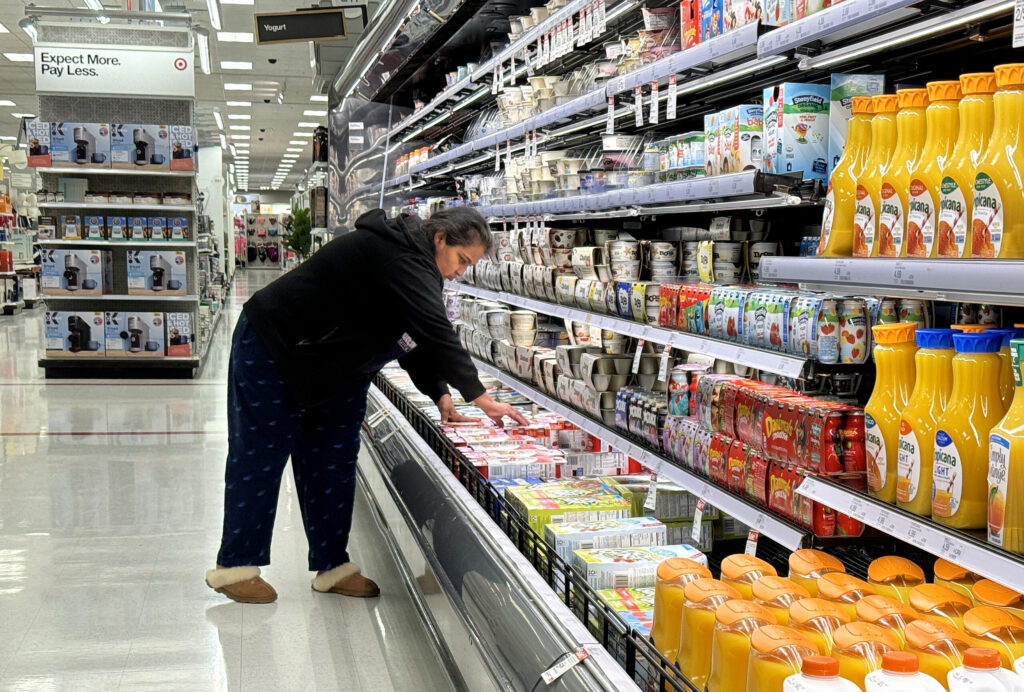A customer shops for food at a grocery store on March 12, 2024 in San Rafael, California. High prices at the grocery store and consumers’ memories of their pre-pandemic budgets may be playing a role in how Americans feel about their finances as recession fears recede. (Justin Sullivan/Getty Images)
At a rate of nearly 19%, Arkansas has the highest prevalence of food insecurity in the nation, according to a U.S. Department of Agriculture report released Wednesday.
The annual study, which was conducted by the USDA’s Economic Research Service, found that Arkansas was one of seven states where the prevalence of food insecurity surpassed the national average of 13.5% in 2023, an increase from 12.8% in 2022.
The report defines food insecurity as being unable, at some time during the year, to provide adequate food for one or more household members because of a lack of resources. Very low food insecurity is the more severe range of food insecurity, where one or more members of a household experienced reduced food intake or disrupted eating patterns because they could not afford enough food.
A steady job doesn’t guarantee food on the table for many Arkansans
Arkansas was one of six states where the prevalence of very low food insecurity was higher than the national average of 5.1%, according to the report. State level data was calculated using estimates for the 3-year period of 2021-2023, lead author Matthew Rabbitt said during a webinar Wednesday.
Arkansas averaged a 6.7% rate of very low food insecurity from 2021-2023, an increase from 5.9% from 2018-2020. The Natural State’s overall food insecurity rate, which includes households experiencing low or very low food insecurity, increased from 12.6% to 18.9% over the same time period.
Nationally, while the percentage of U.S. households that were food insecure in 2023 increased from 2022, households experiencing very low food insecurity stayed the same at 5.1%. However, Rabbit said the percentage of households experiencing very low food insecurity in 2023 was significantly higher than a rate of about 3.8% in 2020 and 2021. Meanwhile, children who experienced food insecurity increased slightly from 8.8% in 2022 to 8.9% in 2023.
“I think the thing to take away from that is that that increase in food insecurity appears to be primarily driven by increases in low food insecurity as opposed to very low food insecurity,” Rabbitt said. “When we combine that with the fact that we know that child food insecurity did not change between 2022 and 2023, we can see that it’s the more moderate forms of food insecurity that were driving that overall increase.”
The prevalence of food insecurity is determined by many factors, including individual household circumstances; federal, state and local policies; and the economy, Rabbitt said. However, he noted the report does not provide an analysis of these possible causes for the observed changes.
The report did find the rate of food insecurity was significantly statistically higher than the national average for certain groups, Rabbitt said, including households with children, households with women living alone, households with Black or Hispanic members, households outside metropolitan areas and households in the South.
GET THE MORNING HEADLINES DELIVERED TO YOUR INBOX
Wednesday’s study supports previous reports that have long ranked Arkansas among the worst in the country for food insecurity. Data released by Feeding America in May, for example, found that more than 567,000 Arkansans, about 18.6% of the state’s population, struggled with food insecurity in 2022. Arkansas had the second highest rate in the country, just 0.2% ahead of Mississippi.
Arkansas’ food insecurity rate has been steadily increasing since 2020, and the 2022 rate was the highest it’s reached in five years, according to Feeding America. Arkansas also ranked second nationwide for the highest food insecurity rate among children, with nearly one in four kids lacking access to healthy options.
In response to the USDA’s new report, Feeding America on Wednesday issued a statement urging action to end hunger.
“We must not accept that 1 in 7 people, including 1 in 5 children, experience food insecurity in the wealthiest nation in the world,” said Feeding America CEO Claire Babineaux-Fontenot. “These numbers confirm what we have been seeing at food banks, pantries, and meal programs and what we have been hearing from people across the country who are confronted with the high prices of essentials like groceries and housing.”
Food insecurity in Arkansas worsens, rate ranks second highest nationwide
Arkansas Food Bank CEO Brian Burton told the Advocate in June that he thinks the increased food insecurity rate could be related to the increased cost of groceries and the loss of additional assistance since the COVID-19 public health emergency ended.
Public assistance still exists through other federal programs. According to the USDA report, about 58% of food-insecure households participated during the month before the 2023 survey in one or more of the three largest federal nutrition assistance programs from the USDA — the Supplemental Nutrition Assistance Program (SNAP); the Special Supplemental Nutrition Program for Women, Infants, and Children (WIC); and the National School Lunch Program.
Arkansas lawmakers approved a 2023 law that raised the asset limit for SNAP, commonly referred to as food stamps, from $2,250 for most families to $5,500. The initial bill proposed raising the limit to $12,500, but sponsor Sen. Jonathan Dismang, R-Searcy, lowered it so the bill had a stronger chance of passing.
Food insecure families could also receive additional assistance this year through a new federal assistance program called the Summer Electronic Benefit Transfer. Over the summer break, students who qualified for the Summer EBT program received $120 on a pre-loaded card to use for groceries, similar to what’s used for SNAP participants.
More than 250,000 Arkansas students were automatically eligible for Summer EBT because they qualified for SNAP or the free- and reduced-lunch program, according to state officials.
SUPPORT NEWS YOU TRUST.

